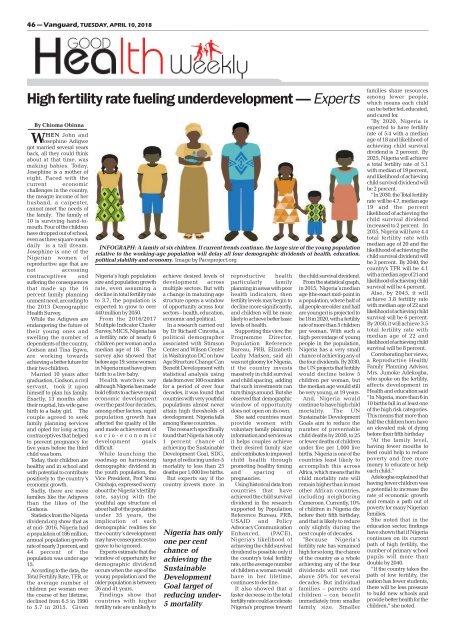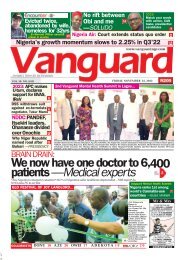10042018 - Why I'm seeking a 2nd term — BUHARI
You also want an ePaper? Increase the reach of your titles
YUMPU automatically turns print PDFs into web optimized ePapers that Google loves.
46 <strong>—</strong> Vanguard, TUESDAY, APRIL 10, 2018<br />
High fertility rate fueling underdevelopment <strong>—</strong> Experts<br />
By Chioma Obinna<br />
WHEN John and<br />
Josephine Adigwe<br />
got married several years<br />
back, all they could think<br />
about at that time, was<br />
making babies. Today,<br />
Josephine is a mother of<br />
eight. Faced with the<br />
current economic<br />
challenges in the country,<br />
the meagre income of her<br />
husband, a carpenter,<br />
cannot meet the needs of<br />
the family. The family of<br />
10 is surviving hand-tomouth.<br />
Four of the children<br />
have dropped out of school,<br />
even as three square meals<br />
daily is a tall dream.<br />
Josephine is one of the<br />
Nigerian women of<br />
reproductive age that are<br />
not accessing<br />
contraceptives and<br />
suffering the consequences<br />
that made up the 16<br />
percent family planning<br />
unment need, according to<br />
the 2013 Demographic<br />
Health Survey.<br />
While the Adigwes are<br />
endangering the future of<br />
their young ones and<br />
swelling the number of<br />
dependents of the country,<br />
Godson and Tina Egwu,<br />
are working towards<br />
achieving a better future for<br />
their two children.<br />
Married 10 years after<br />
graduation, Godson, a civil<br />
servant, took it upon<br />
himself to plan his family.<br />
Exactly, 13 months after<br />
their nuptial, his wife gave<br />
birth to a baby girl. The<br />
couple agreed to seek<br />
family planning services<br />
and opted for long acting<br />
contraceptives that helped<br />
to prevent pregnancy for<br />
five years before the third<br />
child was born.<br />
Today, their children are<br />
healthy and in school and<br />
with potential to contribute<br />
positively to the country’s<br />
economic growth.<br />
Sadly, there are more<br />
families like the Adigwes<br />
than the likes of the<br />
Godsons.<br />
Statistics from the Nigeria<br />
dividend.org show that as<br />
at mid- 2016, Nigeria had<br />
a population of 186 million,<br />
annual population growth<br />
rate of nearly 3 percent, and<br />
44 percent of the<br />
population was under age<br />
15.<br />
According to the data, the<br />
Total Fertility Rate, TFR, or<br />
the average number of<br />
children per woman over<br />
the course of her lifetime,<br />
declined from 6.5 in 1990<br />
to 5.7 in 2015. Given<br />
INFOGRAPH: A family of six children. If current trends continue, the large size of the young population<br />
relative to the working-age population will delay all four demographic dividends of health, education,<br />
political stability and economy. Image by Paceproject.org<br />
Nigeria’s high population<br />
size and population growth<br />
rate, even assuming a<br />
decline in total fertility rate<br />
to 3.7, the population is<br />
expected to grow to over<br />
440 million by 2050.<br />
From the 2016/2017<br />
Multiple Indicator Cluster<br />
Survey, MICS, Nigeria has<br />
a fertility rate of nearly 6<br />
children per woman and a<br />
median age of 18. The<br />
survey also showed that<br />
before age 19, some women<br />
in Nigeria must have given<br />
birth to a live baby.<br />
Health watchers say<br />
although Nigeria has made<br />
bold efforts to achieve rapid<br />
economic development<br />
over the past four decades,<br />
among other factors, rapid<br />
population growth has<br />
affected the quality of life<br />
and made achievement of<br />
socio-economic<br />
development goals<br />
difficult.<br />
While launching the<br />
roadmap on harnessing<br />
demographic dividend in<br />
the youth population, the<br />
Vice President, Prof Yemi<br />
Osinbajo, expressed worry<br />
about the Nigeria’s fertility<br />
rate, saying with the<br />
youthful age structure of<br />
about half of the population<br />
under 35 years, the<br />
implication of such<br />
demographic realities for<br />
the country’s development<br />
may have consequences too<br />
grave to be ignored.<br />
Experts estimate that the<br />
window of opportunity for<br />
demographic dividend<br />
occurs when the age of the<br />
young population and the<br />
older population is between<br />
26 and 41 years.<br />
Findings show that<br />
countries with higher<br />
fertility rate are unlikely to<br />
achieve desired levels of<br />
development across<br />
multiple sectors. But with<br />
a change in maturing age<br />
structure opens a window<br />
of opportunity across four<br />
sectors – health, education,<br />
economic and political.<br />
In a research carried out<br />
by Dr Richard Cincotta, a<br />
political demographer<br />
associated with Stimson<br />
Center and Wilson Center<br />
in Washington DC on how<br />
Age Structure Change Can<br />
Benefit Development with<br />
statistical analysis using<br />
data from over 100 countries<br />
for a period of over four<br />
decades, it was found that<br />
countries with very youthful<br />
populations almost never<br />
attain high thresholds of<br />
development. Nigeria falls<br />
among these countries.<br />
The research specifically<br />
found that Nigeria has only<br />
1 percent chance of<br />
achieving the Sustainable<br />
Development Goal, SDG,<br />
target of reducing under-5<br />
mortality to less than 25<br />
deaths per 1,000 live births.<br />
But experts say if the<br />
country invests more in<br />
Nigeria has only<br />
one per cent<br />
chance of<br />
achieving the<br />
Sustainable<br />
Development<br />
Goal target of<br />
reducing under-<br />
5 mortality<br />
reproductive health<br />
particularly family<br />
planning in areas with poor<br />
health indicators, then<br />
fertility levels may begin to<br />
decline more significantly,<br />
and children will be more<br />
likely to achieve better basic<br />
levels of health.<br />
Supporting this view, the<br />
Programme Director,<br />
Population Reference<br />
Bureau, PRB, Elizabeth<br />
Leahy Madsen, said all<br />
was not gloomy for Nigeria,<br />
if the country invests<br />
massively in child survival<br />
and child spacing, adding<br />
that such investments can<br />
turn things around. But she<br />
observed that demographic<br />
window of opportunity<br />
does not open on its own.<br />
She said countries must<br />
provide women with<br />
voluntary family planning<br />
information and services as<br />
it helps couples achieve<br />
their desired family size<br />
and contributes to improved<br />
child health through<br />
promoting healthy timing<br />
and spacing of<br />
pregnancies.<br />
Using historical data from<br />
countries that have<br />
achieved the child survival<br />
dividend in the research<br />
supported by Population<br />
Reference Bureau, PRB,<br />
USAID and Policy<br />
Advocacy Communication<br />
Enhanced, (PACE),<br />
Nigeria's likelihood of<br />
achieving the child survival<br />
dividend is possible only if<br />
the country's total fertility<br />
rate, or the average number<br />
of children a woman would<br />
have in her lifetime,<br />
continues to decline.<br />
It also showed that a<br />
faster decrease in the total<br />
fertility rate could accelerate<br />
Nigeria's progress toward<br />
the child survival dividend.<br />
From the statistical graph,<br />
in 2015, Nigeria’s median<br />
age (the exact mid-point in<br />
a population, where half of<br />
all people are older and half<br />
are younger) is projected to<br />
be 18 in 2020, with a fertility<br />
rate of more than 5 children<br />
per woman. With such a<br />
high percentage of young<br />
people in the population,<br />
Nigeria has a very small<br />
chance of achieving any of<br />
the four dividends. By 2030,<br />
the UN projects that fertility<br />
would decline below 5<br />
children per woman, but<br />
the median age would still<br />
be very young, at 19 years.<br />
And, Nigeria would<br />
continue to have high child<br />
mortality. The UN<br />
Sustainable Development<br />
Goals aim to reduce the<br />
number of preventable<br />
child deaths by 2030, to 25<br />
or fewer deaths of children<br />
under five per 1,000 live<br />
births. Nigeria is one of the<br />
countries least likely to<br />
accomplish this across<br />
Africa, which means that its<br />
child mortality rate will<br />
remain higher than in most<br />
other African countries,<br />
including neighboring<br />
Cameroon. Currently, 10%<br />
of children in Nigeria die<br />
before their fifth birthday,<br />
and that is likely to reduce<br />
only slightly during the<br />
next couple of decades.<br />
"Because Nigeria’s<br />
fertility rate has remained<br />
high for so long, the chance<br />
of the country as a whole<br />
achieving any of the four<br />
dividends will not rise<br />
above 50% for several<br />
decades. But individual<br />
families – parents and<br />
children – can benefit<br />
immediately from smaller<br />
family size. Smaller<br />
families share resources<br />
among fewer people,<br />
which means each child<br />
can be better fed, educated,<br />
and cared for.<br />
"By 2020, Nigeria is<br />
expected to have fertility<br />
rate of 5.4 with a median<br />
age of 18 and likelihood of<br />
achieving child survival<br />
dividend is 2 percent. By<br />
2025, Nigeria will achieve<br />
a total fertility rate of 5.1<br />
with median of 19 percent,<br />
and likelihood of achieving<br />
child survival dividend will<br />
be 2 percent.<br />
“In 2030, the Total fertility<br />
rate will be 4.7, median age<br />
19 and the percent<br />
likelihood of achieving the<br />
child survival dividend<br />
increased to 2 percent. In<br />
2035, Nigeria will have 4.4<br />
total fertility rate with<br />
median age of 20 and the<br />
likelihood of achieving the<br />
child survival dividend will<br />
be 3 percent. By 2040, the<br />
country's TFR will be 4.1<br />
with a median age of 21 and<br />
likelihood of achieving child<br />
survival will be 4 percent.<br />
Also, by 2045, it will<br />
achieve 3.8 fertility rate<br />
with median age of 22 and<br />
likelihood of achieving child<br />
survival will be 6 percent.<br />
By 2050, it will achieve 3.5<br />
total fertility rate with<br />
median age of 22 and<br />
likelihood of achieving child<br />
survival will be 8 percent.<br />
Corroborating her views,<br />
a Reproductive Health/<br />
Family Planning Advisor,<br />
Mrs. Jumoke Adekogba,<br />
who spoke on the fertility,<br />
affects development in<br />
Health and education said<br />
“In Nigeria, more than 6 in<br />
10 births fall in at least one<br />
of the high risk categories.<br />
This means that more than<br />
half the children born have<br />
an elevated risk of dying<br />
before their fifth birthday<br />
“At the family level,<br />
having fewer mouths to<br />
feed could help to reduce<br />
poverty and free more<br />
money to educate or help<br />
each child.”<br />
Adekogba explained that<br />
having fewer children was<br />
a potential to increase the<br />
rate of economic growth<br />
and remain a path out of<br />
poverty for many Nigerian<br />
families.<br />
She noted that in the<br />
education sector, findings<br />
have shown that if Nigeria<br />
continues on its current<br />
path of high fertility, the<br />
number of primary school<br />
pupils will more than<br />
double by 2040.<br />
“If the country takes the<br />
path of low fertility, the<br />
nation has fewer students,<br />
there will be less pressure<br />
to build new schools and<br />
provide better health for the<br />
children,” she noted.


















